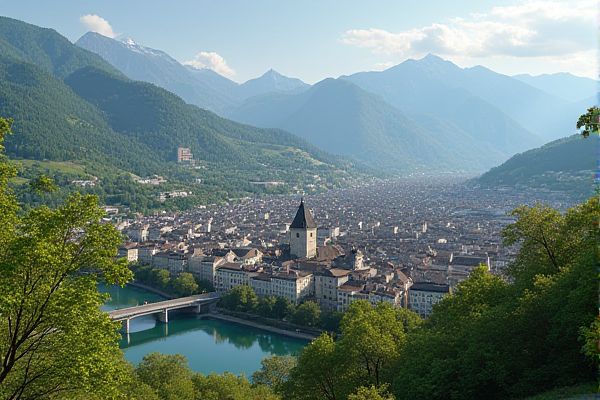
Transportation and commuting in Austria: Extensive public transportation network. Efficient train services - OBB. Comprehensive tram systems. Vienna U-Bahn (subway) network. Biking-friendly cities. Affordable public transit passes. Regional and intercity bus services. Car-sharing options available. Strict parking regulations. Well-maintained road infrastructure.
Extensive public transportation network
Austria boasts an extensive and reliable public transportation network, comprising trains, trams, buses, and metro lines, making it easy and affordable to commute without the need for a car. Major cities like Vienna have comprehensive systems, operated by companies such as Wiener Linien and OBB, providing efficient services to both residents and tourists. For more detailed information, the website Expatica offers valuable insights into the various transportation options available throughout Austria.
Efficient train services - ÖBB
ÖBB, the Austrian Federal Railways, provides highly efficient train services with an impressive 97% punctuality rate. They operate extensive national and international routes, including high-speed trains such as the Railjet and overnight Nightjet services. With a variety of ticket options available, ÖBB ensures a comfortable journey by offering amenities like free WiFi, comfortable seating, and onboard services. For more detailed information on these services and transportation options in Austria, visit the Expatica website.
Comprehensive tram systems
Austria, particularly Vienna, boasts one of the most extensive and historic tram systems in the world. The Vienna tram network, operating since 1865, covers around 171 km, making it one of the largest tram networks globally, with 30 standard lines, standard gauge tracks, and electric power from overhead cables. Other cities like Linz and Graz also have significant tram systems, each with unique characteristics such as different track gauges and integration with other public transport services. To explore more about this fascinating aspect of the city's infrastructure, you can visit the Wikipedia page on Trams in Vienna.
Vienna U-Bahn (subway) network
The Vienna U-Bahn network consists of five lines (U1 to U6), operating from approximately 5:00 am to midnight, with 24-hour service on Fridays, Saturdays, and public holidays at 15-minute intervals. The network spans 83.1 kilometers and serves 109 stations. It is almost entirely barrier-free, providing accessibility to all passengers. Commuters can choose from a variety of ticket options, including single, multi-day, and city cards. For more comprehensive details on navigating the city, visit the Vienna U-Bahn webpage, which offers up-to-date travel information.
Biking-friendly cities
In Austria, Salzburg and Graz are ranked as the most biking-friendly cities, with Salzburg standing out for its accessibility to the city center and one-way streets open to cyclists. In contrast, Vienna and Linz are at the bottom of the list due to their less satisfactory cycling infrastructure. For more detailed insights and a comprehensive city comparison, visit their analysis on Austria's Cyclists Satisfaction.
Affordable public transit passes
Austria's KlimaTicket O is an affordable annual transit pass, allowing unlimited use of all public transportation services across the country. Priced at EUR1,095, it offers discounted rates of EUR821 for young adults, seniors, and students. This initiative, highlighted on the Seamless Bay Area website, aims to encourage the use of public transit to address climate change and is supported by a robust and frequent transit network.
Regional and intercity bus services
ÖBB Postbus plays a crucial role in Austria's public transport system by operating approximately 800 regional bus services, which connect around 1,800 municipalities and facilitate the transport of 208 million passengers annually, including a significant number of schoolchildren. The company is vital for ensuring connectivity in rural areas and actively participates in tenders organized by local authorities to maintain the quality and reliability of its services. For more information on their services, you can visit the website of ÖBB Postbus.
Car-sharing options available
In Austria, innovative car-sharing options are reshaping mobility with a focus on sustainability and convenience. Services like Beecar in Kufstein offer environmentally conscious solutions by allowing residents to reserve and use electric vehicles seamlessly through a booking platform. This service includes essential factors such as insurance, electricity costs, and vehicle maintenance, providing a comprehensive package for users. Similarly, Sharetoo Carsharing by Porsche Bank is enhancing mobility in Austria, especially in Vienna, with a flexible approach that utilizes electric vehicles accessed via an app. This model not only ensures a sustainable transportation alternative but also eliminates ongoing costs for maintenance and insurance, making it an economical choice for users in urban settings.
Strict parking regulations
In Austria, strict parking regulations include prohibitions on parking in front of yellow or red road lines, within 3 meters of a fire hydrant, and in areas marked with "no stopping / parking" signs. Parking in short-term zones, such as those in Vienna, requires payment and adherence to time limits, with significant fines for violations. For more detailed information about these regulations, visit the official Car Parking website. Fines can range significantly, reflecting the importance of following the guidelines closely to avoid any penalty.
Well-maintained road infrastructure
Austria's road infrastructure is well-maintained, with a quality score of 6 out of 7, surpassing most other countries. The nation has maintained an impressive average score of 6.17 from 2006 to 2019. This commendable quality can be attributed to the significant investment in road maintenance and construction, exemplified by ASFINAG's substantial 1.1 billion euros investment in 2021 for motorways and expressways. For more detailed insights, visit the Austria Road Quality page, which provides a comprehensive overview of the country's infrastructure prowess.
